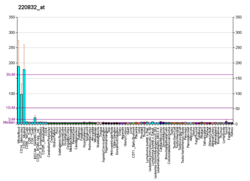Toll-like receptor 8
Toll-like receptor 8 is a protein that in humans is encoded by the TLR8 gene.[5] TLR8 has also been designated as CD288 (cluster of differentiation 288). It is a member of the toll-like receptor (TLR) family.
Function
TLR8 seems to function differently in humans and mice. Until recently, TLR8 was believed to be nonfunctional in mice, but it seems to counteract TLR7 activity[6][7]
The TLR family plays a fundamental role in pathogen recognition and activation of innate immunity. TLRs are highly conserved from Drosophila to humans and share structural and functional similarities. They recognize pathogen-associated molecular patterns (PAMPs) that are expressed on infectious agents, and mediate the production of cytokines necessary for the development of effective immunity. The various TLRs exhibit different patterns of expression. This gene is predominantly expressed in lung and peripheral blood leukocytes, and lies in close proximity to another family member, TLR7, on chromosome X.[8]
TLR8 can recognize GU-rich single-stranded RNA.[9] However, the presence of GU-rich sequences in the single-stranded RNA is not sufficient to stimulate TLR8.[10] TLR8 recognizes G-rich oligonucleotides.[11]
TLR8 is an endosomal receptor that recognizes single stranded RNA (ssRNA), and can recognize ssRNA viruses such as Influenza, Sendai, and Coxsackie B viruses. TLR8 binding to the viral RNA recruits MyD88 and leads to activation of the transcription factor NF-κB and an antiviral response.[12] TLR8 recognizes single-stranded RNA of viruses such as HIV and HCV.[9][10]
TLR7 is functional both in human and mouse, but TLR8 is only functional in human.[7]
Clinical significance
Genetic variants in TLR8 has recently been linked to susceptibility to pulmonary tuberculosis.[13]
As a drug target
TLR8 agonists (e.g. VTX-2337) have undergone clinical trials as immune stimulants in combination therapy for some cancers.[14]
References
- ^ a b c GRCh38: Ensembl release 89: ENSG00000101916 – Ensembl, May 2017
- ^ a b c GRCm38: Ensembl release 89: ENSMUSG00000040522 – Ensembl, May 2017
- ^ "Human PubMed Reference:". National Center for Biotechnology Information, U.S. National Library of Medicine.
- ^ "Mouse PubMed Reference:". National Center for Biotechnology Information, U.S. National Library of Medicine.
- ^ Du X, Poltorak A, Wei Y, Beutler B (September 2000). "Three novel mammalian toll-like receptors: gene structure, expression, and evolution". European Cytokine Network. 11 (3): 362–71. PMID 11022119.
- ^ Demaria O, Pagni PP, Traub S, de Gassart A, Branzk N, Murphy AJ, Valenzuela DM, Yancopoulos GD, Flavell RA, Alexopoulou L (October 2010). "TLR8 deficiency leads to autoimmunity in mice". The Journal of Clinical Investigation. 120 (10): 3651–62. doi:10.1172/JCI42081. PMC 2947223. PMID 20811154.
- ^ a b Sarvestani ST, Williams BR, Gantier MP (August 2012). "Human Toll-like receptor 8 can be cool too: implications for foreign RNA sensing". Journal of Interferon & Cytokine Research. 32 (8): 350–61. doi:10.1089/jir.2012.0014. PMID 22817608.
- ^ "Entrez Gene: TLR8 toll-like receptor 8".
- ^ a b Heil F, Hemmi H, Hochrein H, Ampenberger F, Kirschning C, Akira S, Lipford G, Wagner H, Bauer S (March 2004). "Species-specific recognition of single-stranded RNA via toll-like receptor 7 and 8". Science. 303 (5663): 1526–9. Bibcode:2004Sci...303.1526H. doi:10.1126/science.1093620. PMID 14976262.
- ^ a b Zhang Y, El-Far M, Dupuy FP, Abdel-Hakeem MS, He Z, Procopio FA, Shi Y, Haddad EK, Ancuta P, Sekaly RP, Said EA (July 2016). "HCV RNA Activates APCs via TLR7/TLR8 While Virus Selectively Stimulates Macrophages Without Inducing Antiviral Responses". Scientific Reports. 6: 29447. Bibcode:2016NatSR...629447Z. doi:10.1038/srep29447. PMC 4935957. PMID 27385120.
- ^ Peng G, Guo Z, Kiniwa Y, Voo KS, Peng W, Fu T, Wang DY, Li Y, Wang HY, Wang RF (August 2005). "Toll-like receptor 8-mediated reversal of CD4+ regulatory T cell function". Science. 309 (5739): 1380–4. Bibcode:2005Sci...309.1380P. doi:10.1126/science.1113401. PMID 16123302.
- ^ "TLR7 and TLR8: Key players in the antiviral response - Innate immunity". invivoGen. Fall 2006.
- ^ Davila S, Hibberd ML, Hari Dass R, Wong HE, Sahiratmadja E, Bonnard C, Alisjahbana B, Szeszko JS, Balabanova Y, Drobniewski F, van Crevel R, van de Vosse E, Nejentsev S, Ottenhoff TH, Seielstad M (October 2008). "Genetic association and expression studies indicate a role of toll-like receptor 8 in pulmonary tuberculosis". PLoS Genetics. 4 (10): e1000218. doi:10.1371/journal.pgen.1000218. PMC 2568981. PMID 18927625.
{{cite journal}}: CS1 maint: unflagged free DOI (link) - ^ Immune Stimulant No Help When Added to Chemotherapy for Recurrent Ovarian Cancer. March 2017
Further reading
- Lien E, Ingalls RR (January 2002). "Toll-like receptors". Critical Care Medicine. 30 (1 Suppl): S1-11. doi:10.1097/00003246-200201001-00001. PMID 11782555.
- Kaisho T, Akira S (February 2002). "Toll-like receptors as adjuvant receptors". Biochimica et Biophysica Acta. 1589 (1): 1–13. doi:10.1016/S0167-4889(01)00182-3. PMID 11909637.
External links
- Toll-Like+Receptor+8 at the U.S. National Library of Medicine Medical Subject Headings (MeSH)





